China Longjing Tea & Green Tea Tour is a tea culture tour in China. If you want to know more about China’s tea culture, it will be a good chance for you to join this tour. Every time you visit a new city, you will have an experienced guide who can tell you some information about local green tea. For instance, on the Hangzhou tea tour, you will go to the producing area of Longjing tea. Your guide will stand in the Longjing Tea Plantation and tell you what Longjing tea is and why it is famous. In Tunxi Ancient Street, your guide will introduce a kind of local green tea -- Tunxi Green tea for you. In Mount Huang, there are many different types of green tea that the local guide can tell you, such as Mount Huang Maofeng tea(Fuzz tip), Taiping Houkui tea, Mount Huang Yingou tea, and so on. You will be surprised at so many sorts of green tea in this tea tour China. Stop dithering and join us now!

Once your aircraft has touched down in Shanghai, your tour guide will be waiting for you there. Then they will escort you to your hotel. Be ready to start your tea tour in China!
Option: Your trip will start tomorrow. But if you are not tired and want to know Shanghai in advance, you can choose to enjoy the Huangpu River Cruise. Huangpu River runs through Shanghai and divides the city into two parts. Then it empties into the Yangtze River. The river is 113 kilometers in length and 300 meters to 770 meters in width. Cruising down the Huangpu River, you will see kinds of the old architecture of different countries on the western shore and modern buildings on the eastern shore. Sometimes, you may see liners or cruises from other countries, too. For this cruise, you will see Gong Qing Forest Park, water tower, and other attractions. It will take you about one hour to have a wonderful sightseeing journey on the Huangpu River.
In the morning, you will first visit the Yu Garden (closed on Mondays). It is a classical garden built in 1559 in the Ming Dynasty (1368-1644). In the beginning, it was a private garden built by Pan Yunduan, a high-ranking official of the Ming Dynasty. Now it has become one of the top attractions in Shanghai. In Yu Garden, you will see a pair of iron lions located at the eastern gallery entrance of Yangshan Hall. They were cast in the Yuan Dynasty (1271-1368) with a history of more than 700 years. Local people placed this pair of iron lions here at the end of the last century. On the right of the entrance, you will see a female crouching iron lion with a little lion under its claw, and a male iron lion crouching on the left with a ball under its claw. In Chinese culture, for such a pair of lion statues, the little lion is a wish for children and the ball symbolizes power. So this pair of lion statues may express the owner’s thought at that time.
Later you will get to Shanghai Old Street, which is not far away from the Yu Garden. It has a total length of 825 meters and used to be a commercial area of old Shanghai, where people could sell goods and buy something they needed. To today, many old buildings are retained and endowed with new functions. For example, you will see tea houses, restaurants, old-style Chinese private banks, and theaters here. Besides, strolling down this street from west to east, you will find some differences between these old buildings in the western section and the eastern section. The old buildings in the western section retain the architectural style of the Ming Dynasty and the old buildings in the eastern section retain the architectural style of the Qing Dynasty (1636-1912). In the western section of this street, ancient buildings have white walls and black roofs, while in its eastern section, old dwellings have horse-head-shaped walls and lattice windows.
After admiring the old buildings of the Ming and Qing Dynasties, you will go to the Xintiandi Area, which is a pedestrian street in the center of Shanghai. In 2003, Xintiandi Area won Urban Land Institute (ULI) Award for Excellence because it achieved excellence in land use practice. In this place, you will feel a mixture of the ancient architecture and modern lifestyle in Shanghai. Xintiandi Area has a kind of special architecture of Shanghai in the late 19th century -- Shikumen, or literally “stone gate”. Each house has a pair of black wooden doors wrapped by a stone arch. So we call it Shikumen. But when you enter these houses, you will find their decoration is so modern. Most of them are stores and restaurants. You can find international galleys, boutiques, coffee shops, and bars here.
After lunch, you will look around the Former French Concession which used to be the largest concession in China. It was at its height in the 1930s as a very fashionable part of Old Shanghai. There are many European buildings in this area. Among them, the Moller Villa is the most popular one, which was completed in 1936. It covers an area of more than 5,000 square kilometers and its garden area is about 2,000 square kilometers. Moller Villa typifies Scandinavian architecture with small windows, thick high walls, and towers. The rooms of the villa are also well-decorated with colorful glasses. There is a romantic story about it. In 1926, a British girl who lived in Shanghai dreamed that she owned a castle that was the same as the castle in Hans Christian Andersen’s fairy tale. So her father built a castle-like Moller Villa for her to fulfill her dream. Although Moller and his family left China soon in 1941, this castle-like Moller Villa has become one popular attraction in Shanghai.
Then you will go to the Bund, which is one of the most charming attractions in Shanghai. It is a waterfront along Shanghai’s famous Huangpu River. The Bund is 1.5 kilometers long. There are 33 classical buildings with different architectural styles, such as Gothic, Baroque, Roman, etc. along the Huangpu River. These buildings have become the symbol of Shanghai. But when you turn to look at the other side of the Huangpu River, you will find tall modern buildings of steel and glass structure. The contrast between the old buildings and modern skyscrapers will make a deep impression on you.
After a tour of the Bund, you will visit Nanjing Road, one of the most prosperous roads in Shanghai with more than 600 stores. It is a paradise for consumers at home and abroad with a total length of 5.5 kilometers. Here are many time-honored brands. Zhang Xiao Quan, for instance, has produced high-quality scissors since 1628, and its products are exported to many countries. Shen Da Cheng, selling Chinese cakes and pastries, was founded in 1875 and has been China-known since the 1930s. Besides, another famous brand, Tong Ren Tang, is also located at the Nanjing Road. It was founded in 1669, specializing in traditional Chinese medicine and therapy.
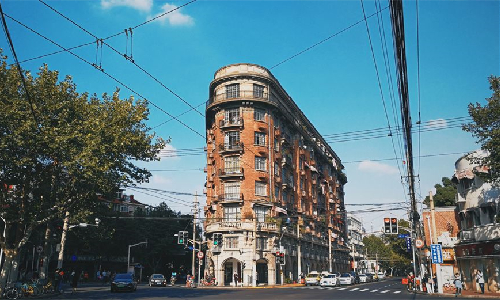
After breakfast, you will visit Zhujiajiao Water Town, which is located 49 kilometers southwest of the Yu Garden. It will take you about one hour and 15 minutes to go there. Zhujiajiao Water Town covers a total area of 47 square kilometers. As a typical ancient water town in south China, it has a reputation as the “Venice in Shanghai, for it is crisscrossed with waterways. There are nine old streets and thousands of ancient dwellings near the river. Thirty-six old bridges were built over the waterways during the Ming and Qing Dynasties. Taking a wooden boat on the river, you will pass under many old bridges and enjoy the ancient buildings comfortably. There are also many tea houses in Zhujiajiao Water Town, such as the luxuriously decorated Fangsheng Bridge Tea house, long-standing Zhujiajiao Club Tea House, and quaint Miao Qu Lou. Besides, there are some simply equipped tea houses with only one or two tables and several benches. Interestingly, you will find a tea house on the ship, too. It must be an impressive part of your tea tour.
After having lunch in Zhujiajiao Water Town, we will drive northeast for about 1.5 hours to the Shanghai Tower. It is 50 kilometers away from Zhujiajiao Water Town. As one of Shanghai’s landmark buildings, the Shanghai Tower has 127 floors above the ground and 5 floors under the ground. Its total height is 632 meters. It is now the tallest building in China. When local people talk about the Shanghai Tower, they will immediately think of its sightseeing platform that is 546-meter high. It is an attraction not to be missed for any visitors who come here. The fastest elevator in the tower will take you to the 118-floor sightseeing platform within 55 seconds. Standing on this 360-degree transparent sightseeing platform, you will have a bird’s eye view of Shanghai’s skyscrapers, such as the Oriental Pearl Tower, Hongkou Football Stadium, Jin Mao Tower, Shanghai World Financial Center, Lupu Bridge. Then, we will take you back to your hotel to have a rest.
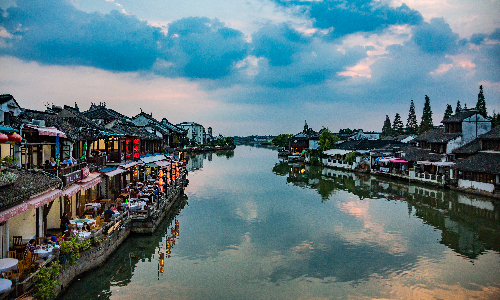

 Hangzhou
Hangzhou After breakfast, our guide will help you to check out from your hotel and you will take the estimated high-speed train G85 08:00/08:45 to Hangzhou. When you get there, we will take you to West Lake. It covers an area of 6.38 square kilometers, surrounded by beautiful mountains on three sides and a vibrant city on one side. In 2011, it was included in the World Heritage List because of its beautiful natural scenes and historical sites, such as its artificial islands within the lake, peach and weeping willow trees, gardens, pagodas, and so on. You will have a chance to enjoy the beauty of West Lake by taking a boat. The West Lake used to have many names before the Tang Dynasty (618-907), such as the Golden Buffalo Lake, the Qiantang Lake, the Xizi Lake, and so on. There is a legend about why the West Lake used to be called the Golden Buffalo Lake. It is said that in the Han Dynasty (202 BC-220 AD), a golden buffalo lived in the lake. Once the lake dried up, the golden buffalo would appear and spat water to fill the lake. However, to win the emperor’s favor, local officials ordered people to drain the lake and catch the golden buffalo after it appeared. Then the golden buffalo spat water at them angrily and drowned them at once! Miraculously, the golden buffalo had disappeared after that and the West Lake has never been dried out any more. For this story, the West Lake had been called Golden Buffalo Lake for many years.
After lunch, you will go to Feilai Peak, another famous attraction of Hangzhou. It is about 168 meters in height with lots of Buddhist stone statues and unique rocks. On the Feilai Peak, there are more than 340 Buddhist stone statues that were made between the Five Dynasties (907-960) and the Yuan Dynasty. The Maitreya statue is the largest Buddhist stone statue on Feilai Peak. It was carved in the Southern Song Dynasty (1127-1279). Surrounded by 18 Buddhist saints, Maitreya lies on his side and beams at every visitor in front of him. Besides, Feilai Peak is also like a stone zoo because it has many rocks of grotesque shapes. Some of these rocks are like a flying dragon, a running elephant, a lying tiger, or a lively monkey. You will never be bored in this amazing place. If you take photos and post them on your Facebook, I am sure you will get many likes.
Then you will go to the Lingyin Temple that covers an area of 87,000 square meters. It was built in 326 and is a famous historical site in Hangzhou now. On its central axis, you will see the Hall of Heavenly Kings, the Main Shrine Hall, and the Medicine Buddha Hall. They are the main buildings of the Lingyin Temple. Other buildings are on either side of them. When you enter the temple, you will first see the Hall of Heavenly Kings. It is about 24 meters in length and 15 meters in width. A Maitreya statue is in the center of the Hall of Heavenly Kings and it is flanked by four heavenly kings that are four guardian kings in the Buddhist faith. Behind the Maitreya statue, you will see a Buddhist god who keeps evil away and guards the temple.
After visiting the Lingyin Temple, you will go to the Longjing Tea Plantation. It covers an area of 1.8 square kilometers at present and has natural conditions suitable for growing tea. The temperature is proper and the mountains here are always enveloped in cloud and mist, which promotes the synthesis and accumulation of amino acids. So the tea leaves of this place are high-quality. As a kind of world-renowned green tea, Longjing tea has a very fine process of picking and making. Each year, tea farmers need to pick all the best tea leaves in few days and roast tea leaves in a complicated way, otherwise, the quality of Longjing tea will not be good enough. For the pot-brewed Longjing tea, you will find the tea color is light green. When you drink a cup of tea, try to smell its lasting and delicate fragrance first, and then taste it. After enjoying Longjing tea, we will take you to the hotel.

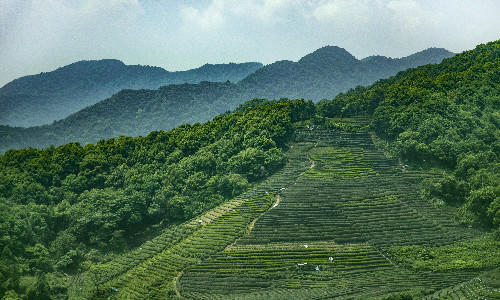
 Huangshan
Huangshan This morning, you will take the estimated high-speed train D5577 09:00/10:51 to Huangshan City, Anhui Province. Then your guide will drive you from Huangshanbei Railway Station to Tunxi Ancient Street. It lies some 14 kilometers to the southeast and you will spend about 30 minutes going there. The Tunxi Ancient Street is a well-preserved pedestrian mall. It has a total length of 1272 meters. About 300 ancient stores line the narrow street, selling the “Four Treasures of the Study” (writing brush, ink stick, ink slab, and paper), native products, and other things. Besides, it is the best place for you to enjoy Tunxi Green tea with a history of more than 1200 years. Tunxi Green tea has emerged as a famous product in the international market in the Ming dynasty and has been sold to many countries since 1913. It is a kind of non-fermented tea. So in order to get the best flavor, the ratio of tea leaves to water should be 1:50 and the temperature of the water should be 85℃-90℃(185°F-194°F). If the condition allows, you can observe the fresh green tea in a glass cup or a white porcelain cup. Lastly, we will drive you back to your hotel.
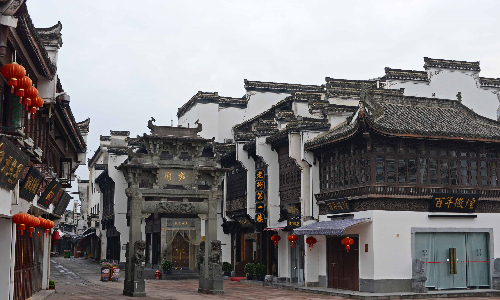
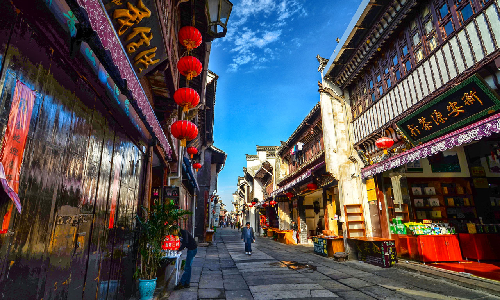
This morning, we will drive for about 54 minutes to Mount Huang. It is situated to the north-west of Huangshan city and the distance between them is about 60 kilometers. After entering Mount Huang, you will visit Yungu Temple first. It is the only way that must be passed when you enter the south entrance of Mount Huang. Then you will take the Yungu cable car to the Beginning-to-Believe Peak that is 1668 meters above sea level. It’s said that the person who named the peak is Huang Xiyuan, a poet of the Ming Dynasty. He didn’t believe when other people told him that this peak was as beautiful as a painting. But when he arrived at this peak, he started to believe that other people’s view was right. So he called it Beginning-to-Believe Peak. Next, you will take an open view of the West Sea Grand Canyon that is one of the famous canyons of Mount Huang. The canyon has a total length of 15 kilometers. You will see many peaks, grotesque stones, and cliffs here. Then you will visit the Dispelling Cloud Pavilion which was built in 1935. In front of the pavilion, there is a platform that covers an area of 70 square meters. You can stand here and lean on the rail to look at canyons and peaks. Then you will walk southwest to see the Flying-over Rock. This huge rock is 12 meters high, 7.5 meters long, and 2.5 meters wide. It stands on a rocky platform that is just about 12-15 meters long and 8-10 meters wide. What amazing scenery it is! After seeing that, you will continue to move forward to the Bright Summit. As one of the main summits of Mount Huang, it is 1841 meters above sea level. This place has more sunlight exposure time than other places because it is higher and flatter. So it is called the Bright Summit and is the best place for visitors to see the sunrise and sunset.
Besides wonderful attractions, there are many types of famous tea in Mount Huang, such as Mount Huang Maofeng tea (Fuzz tip), Taiping Houkui tea, Mount Huang Yingou tea, and so on. Mount Huang Maofeng tea is a kind of famous green tea in China. It consists of one leave and one downy-covered bud. When you drink it, you will feel a fresh and gentle flavor. Taiping Houkui tea is also a kind of green tea. It was first produced in 1859 in the Qing Dynasty and has a fragrance of orchids. If you look at its leaves carefully, you will find their leaf veins are a little red. In Mount Huang, you will also find Mount Huang Yingou tea. Yingou means a silver hook in Chinese, and the leaves of Moung Huang Yingou tea are also like silver hooks. After enjoying different kinds of tea in Mount Huang, we will help you to do the check-in at the hotel on the Bright Summit and you can see the sunset and the evening glow there.
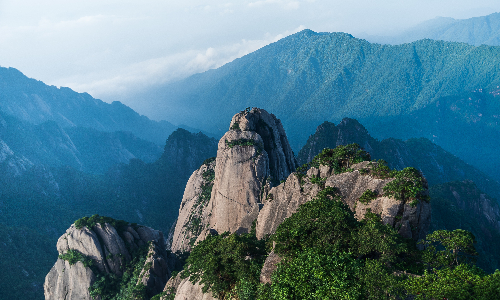

 Beijing
Beijing Today, you will get up early to see the sunrise on Mount Huang. You can go out of the hotel or just stay in the hotel’s room to see the sun slowly rising. It will be an unforgettable experience for you. Then you will walk to the Dawn Pavilion to see the beautiful scenery of Mount Huang. Next, you will go to the Lion Peak which looks like a lion crouching there. It is the best place to see the Stone Monkey Watching the Sea. It’s said that the stone monkey used to be an elf who fell in love with a girl. So it pretended to be a handsome young man and proposed to her. The girl accepted its marriage proposal. However, the elf was drunk on its wedding day and showed its original appearance. The girl was so angry when she saw it and left here forever. The elf missed her so much, but it couldn’t find her. So the elf climbed to the top of the mountain and looked at the girl’s hometown every day. Many years later, it became a stone monkey. After seeing the Stone Monkey Watching the Sea, you will walk to the cable car station and take a cable car down the mountain.
Then you will take the estimated high-speed train G7498 12:21/13:47 to Hangzhou. After arriving at the Hangzhoudong Railway Station, your guide will take you to Hangzhou Xiaoshan International Airport, some 35 kilometers southeast of the railway station. It will take about 42 minutes to get there. Then you will take the estimated flight CA8367 16:00/18:20 to Beijing. The local guide in Beijing will take you to the hotel.
After breakfast, you will visit Tian’anmen Square. It was built in 1417 in the Ming Dynasty. Tian’anmen Square is 880 meters long and 500 meters wide. It covers an area of 440,000 square meters and can accommodate 1 million people for large-scale national activities. In this place, you will see a building called Tian’anmen Gate Tower, which has five gates. The five gates are the main entrances for entering the royal palace- the Forbidden City. However, in the Ming Dynasty and the Qing Dynasty, strict stipulations were made for the people who are allowed to enter the royal palace through the five gates. For the middle gate, only the most dignified people could pass through it under specific conditions. Of course, the emperor could pass through this gate without any limitation. In addition to the emperor, the emperor’s parents were also allowed to pass through this gate; the empress was allowed to pass through it only on her wedding day; the Number One Scholar in imperial competitive examination was allowed to pass through the middle gate on the day that he was announced to meet the emperor on the imperial court. The other nobles and senior officials were only allowed to enter the royal palace through other gates. Anybody who violated these stipulations would be punished heavily.
Then you will go to the Forbidden City (Closed on Mondays) which was built in 1420. It is 961 meters in length and 753 meters in width, and it covers an area of 720,000 square meters with over 9,000 rooms. The largest hall in the Forbidden City is the Hall of Supreme Harmony. If you look up at the roof ridges of this hall, you will find eleven figurines on the corner of each roof ridge, including the figurine of an immortal riding a phoenix and figurines of 10 Chinese mythical creatures. There is a legend about this immortal. It’s said that, in the Warring State Period (453 BC-221 BC), the king of the State of Qi was hunted down by his enemy to a river. Unfortunately, there was no bridge or even a boat for him to go across the river. At this critical moment, a phoenix flew to this place and landed nearby. Seeing this phoenix, the king ran to it and got on its back without any hesitation. Miraculously, the phoenix flew up high into the sky as soon as the king got on the phoenix’s back. Some people said the phoenix took the king to the heaven and became an immortal. The king was so lucky that he avoided being killed by his enemy. Because of this story, the figurine of an immortal riding a phoenix was always regarded as one symbol of bringing good luck. And it was often applied to the royal architecture.
After lunch, you will visit the Temple of Heaven. It is located in the south of Beijing and was built in the Ming Dynasty. It covers an area of 2,730,000 square meters, and it is much larger than the Forbidden City. In the Ming and the Qing Dynasty, ceremonies of offering sacrifice to Heaven and praying for good harvest would be held at the Temple of Heaven. The ceremony would be held in the morning. After fasting in the Abstinence Hall, the emperor went to the Circular Mound Altar. More than 700 kinds of sacrificial offerings were put on the Circular Mound Altar to be burned. In Chinese sacrificial tradition, the fume produced by burning the sacrificial offerings would fly to the heaven with people’s wishes and respect. Under the altar, dozens of performers were playing music. Then the emperor and hundreds of officials would kneel before the altar to worship Heaven. After all of the sacrificial offerings were burned up, the whole ceremony would be completed.
Next, you will go to visit the Hutongs. These Hutongs have a history of more than 700 years. There were more than 3,000 Hutongs here in the 1940s. The narrowest Hutong is called Qianshi Hutong. Its narrowest place is only 0.4 meters in width. The oldest hutong is Sanmiao Jie. It was built in the Liao Dynasty (916-1125) and was the most prosperous place about 900 years ago. The Hutong with the most curves is Jiuwan Hutong. Jiuwan means nine curves in Chinese. However, there are 13 curves in Jiuwan Hutong. You can have a rickshaw tour in Hutong. It’s said that the rickshaw is probably the oldest form of taxi in Asia. You will have a chance to feel the ordinary Beijinger’s life in Hutong. You may see some people playing chess, singing songs, selling goods, and playing cards, etc. At the end of the day, the local guide will take you back to your hotel.

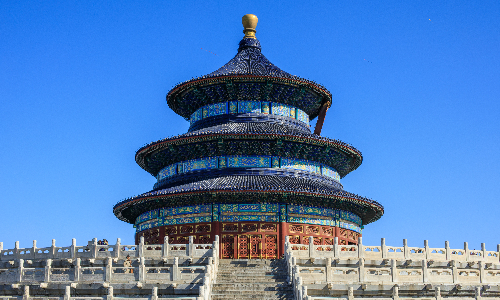
In the morning, it will take you about 67 minutes to go to the Ming Tombs. It is located 48 kilometers northwest of Beijing. They are well-preserved imperial tombs where 13 emperors of the Ming Dynasty, 23 empresses, more than 30 imperial concubines, 2 crown princes, and 2 court eunuchs were buried. In 2003, the Ming Tombs was admitted as one world heritage. The Ming Tombs has 13 tombs, such as Chang Tomb, Zhao Tomb, and Ding Tomb. You will visit the Ding Tomb. It is the tomb of the 13th emperor of the Ming Dynasty and covers an area of 182,000 square meters. The archaeologists found many cultural treasures in this tomb, such as a silver spoon, gilded earrings, the Gold Crown of Emperor Wanli, and so on. The Gold Crown of Emperor Wanli is very famous. Its front part was woven with 518 strips of golden threads. The golden threads are only 0.2 millimeters in diameter. There are two meshes on the top of the gold crown, and they are like a rabbit’s two ears. In its rear part, you will see a pattern of two dragons. Each piece of the dragon is welded together. It is not a kind of easy work. It is said that, there are 8,400 pieces of golden scales on the dragons.
After lunch, you will visit the Mutianyu Great Wall. It is in the northeast of the Ming Tombs, and the distance between them is about 41 kilometers. You will spend about 68 minutes on the way there. The Mutianyu Great Wall is 5,400 meters long and was built in 1368. Its vegetation coverage rate is more than 96%, and it is the home of many species of plants. You will see pine trees, Chinese arborvitaes, chestnut trees, walnut trees, and so on. You can take a chairlift up to enjoy the beauty of the Mutianyu Great Wall. And you can choose to take the Toboggan down or take the Chairlift down. Then we will drive southwest for about 2 hours(72 kilometers) to downtown Beijing. On the way back to your hotel, we will park close to the Water Cube(National Aquatic Center) and the Bird Nest(National stadium) for you to take some pictures. You’ll gain many likes if you post them on your Facebook.


Today, your great tea tour will come to an end. It’s time for you to go home. Your guide will pick you up at your hotel and escort you to the airport.
Editor: Xinli Zhang
Proofreader: Yan Liu
| City | Five Star hotel list | Four Star hotel list |
|---|---|---|
| Shanghai | Ocean Hotel Shanghai | Courtyard by Marriott Shanghai Central |
| Hangzhou | Landison Plaza Hotel | Best Western Plus Meiyuan Hotel Hangzhou |
| Huangshan | Huangshan International Hotel | Huangshan International Hotel |
| Beijing | Sunworld Dynasty Hotel Beijing Wangfujing | Sunworld Hotel Wangfujing |
 |
![]() About your child or infant, please contact us for a discounted price.
About your child or infant, please contact us for a discounted price.



We started with a few days in Beijing & ended in Shanghai, from where we visited the Forbidden City and Great Wall. In between we visited Terra Cotta Warriors Museum, Panda Base, Shanghai Disneyland.

We had a wonderful holiday in China which will remain long in the memory. China is a breathtakingly beautiful country full of splendid temples and palaces, mountains and rivers, peaceful rural scenes and bustling shopping streets.
 QUICK ENQUIRY
QUICK ENQUIRY